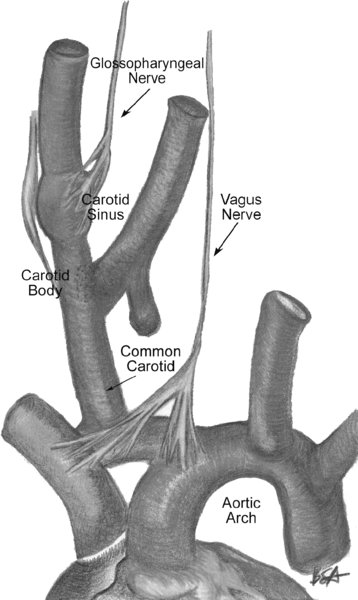Description
The carotid sinus is a baroreceptor that is located at the bifurcation of the internal external carotid artery. It is involved in blood pressure heart rate homeostasis.
- The carotid sinus reflex describes baroreceptor-mediated hemodynamic suppression to high arterial wall tensions resulting in hypotension bradycardia.
- When a rise in arterial pressure stretches the baroreceptors, sodium channels are activated afferent signals (via the glossopharyngeal nerve) travel to central nuclei, including the nucleus tractus solitarius. From there, long preganglionic efferent fibers via the vagus nerve propagate to the heart synapse on postganglionic neurons in myocardial tissue. These postganglionic neurons directly stimulate pacemaker cells conducting pathways to slow down the heart. The reflex can be elicited manually by external carotid massage.
- Bronchoconstriction is another possible side effect of direct stimulation of the carotid sinus.
The carotid sinus is located within the bifurcation of the internal external carotid arteries.
FIGURE 1. Carotid Sinus.
The baroreceptor is located at the bifurcation of the internal external carotid arteries. It sends afferent input to the central nuclei via the glossopharyngeal nerve efferent input travels to the heart via the vagus nerve.
Illustration by Brooke Albright, MD
Physiology/Pathophysiology
- Atheromatous plaques located within the region of the carotid sinus impair the sensitivity of the baroreceptor stretch receptors. Once these plaques are removed, such as in carotid endarterectomy surgery, an exaggerated response to changes in BP cardiac rhythms may be encountered (1).
- Increased age, hypertension, diabetes can all lead to impaired cardio-vagal reflex responses increased cardiovascular morbidity (1).
- In the transplanted heart, vagus nerve innervation is severed. Parasympathetic stimulation via carotid massage, arterial wall stretch of the carotid sinus, the Valsalva maneuver are not effective in slowing the heart rate. Indirect acting medications are also ineffective in the denervated heart.
- Carotid sinus syndrome (CSS) is a disease characterized by nausea, vomiting, dizziness, syncope, severe hypotension, asystole due to hypersensitivity of the carotid sinus. It is a recognized complication following carotid endarterectomy surgery in some patients. Treatment may require a pacemaker, glossopharyngeal nerve block/ablation, or surgical denervation of the glossopharyngeal nerve at the level of the carotid bifurcation (2). If a regional nerve block is selected for therapy, an electrical stimulating needle is passed anterior to the styloid process until the patient complains of vague sensations in the regions supplied by the nerve, such as the external ear or pharynx. If performance of block successfully reduces symptoms after testing with carotid massage, then the nerve is ablated with ethanol.
- New technology development testing related to stimulation of the carotid sinus is underway for the treatment of drug-resistant hypertension. The Rheos Multicenter Feasibility Trial is currently investigating an implantable pulse generator bilateral perivascular carotid sinus leads that electrically activate the afferent limbs of the carotid sinus baroreflex reduce overall sympathetic vascular tone over time. FDA-approved phase II clinical trials have been promising (3).
- Carotid artery stenting can lead to severe bradycardia cardiac rhythm disturbances during balloon angioplasty. Different techniques have been utilized with varying degrees of success to prevent episodes of bradycardia, including intravenous injection of atropine, injection of local anesthetic into the carotid sinus prior to dilation. Infiltration of the carotid sinus with 5 mL of 1% lidocaine 3 minutes before dilation allowed stable hemodynamics did not lead to bradycardia in one study (4).
- Carotid endarterectomy surgery may lead to deterioration of baroreceptor function at the point when the atheromatous plaque is removed, although the exact mechanism by which this happens is unclear.
- Some theories suggest that removal of the plaque results in denervation of the baroreceptor nerve fibers within the arterial wall, which could result in sympathomimetic electrocardiographic changes hypertension.
- If carotid afferent fibers are maintained intact, then postoperative hypotension is possible due to hyperactivity of the newly exposed carotid sinus to the increased perceived BP.
- Prophylactic administration of intravenous atropine is advocated by some anaesthetists whenever manipulation of the carotid sinus is expected.
- Volatile anesthetics have been shown to depress baroreflex control of heart rate in a concentration-dependant manner continue to exert depressive effects after emergence from general anesthesia (5).
- Prolonged nitroprusside infusion as well as sevoflurane anesthesia can lead to a shift in the baroreceptor reflex resting set point such that perturbations of the carotid sinus result in smaller fluctuations of hemodynamics (6).
- Surgery for CSS may include “adventitial stripping,” whereby the proximal carotid artery is opened the sinus is denervated over an area of at least 3 cm. Postoperative monitoring is matory since wide variations in heart rate BP can occur (6).
Pediatric Considerations
| The parasympathetic nervous system is fully functional at birth in the neonate, including the baroreceptor reflex. In contrast, the sympathetic nervous system is not complete until 4–6 months of age. As a result, certain noxious stimuli may cause bradycardia in neonates. During general anesthesia, the responsiveness of the baroreceptor reflex may be reduced by volatile anesthetics. |
